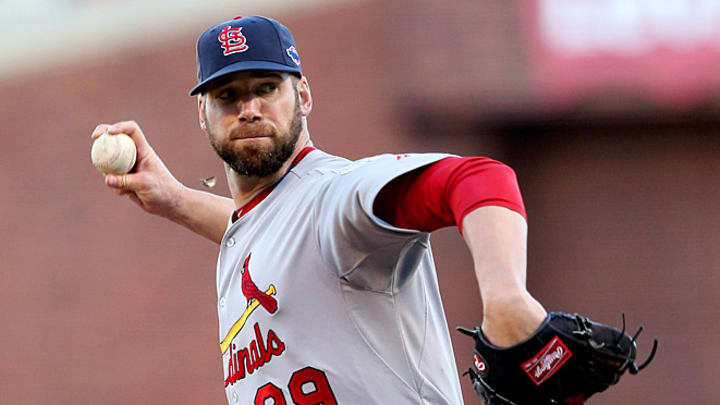Loss of Carpenter leaves leadership void with Cardinals


For nearly a decade Chris Carpenter has been a sinker-slinging embodiment of the Cardinals' Reclamation Rotation, a band of down-and-out starters whose careers were rejuvenated with the Redbirds under the watchful eye of former longtime pitching Dave Duncan.
On Tuesday, however, the club revealed that the 37-year-old Carpenter has suffered a recurrence of the nerve issue in his neck and pitching shoulder that sidelined him for most of the 2012 season and now jeopardizes both his '13 season and his career.
At a press conference in St. Louis, general manager Jon Mozeliak said it was "very unlikely" Carpenter would return this season and, if true, his ailment has hastened not only the end of a distinguished career for Carpenter but also has accelerated the franchise's transition from its old guard to its young guns.
Any time a ballclub loses a pitcher of Carpenter's caliber -- in six full and three partial seasons with the Cardinals he has gone 95-44 with a 3.07 ERA, one Cy Young award and two other top-three finishes -- it's a blow, especially when the manager, Mike Matheny, described him as possibly the best competitor and leader he's ever seen.
But St. Louis is equipped to replace at least most of Carpenter's production, though not his leadership, thanks to a bevy of top-flight arms who reached the majors leagues last season, a group headlined by Shelby Miller, Trevor Rosenthal and Joe Kelly. The franchise's ability to produce quality major leaguers at an increasingly high rate -- called the Cardinal Churn in this space last year -- keeps it in contention year after year and less dependent on salvaging starters in need of help.
Those promising pitchers will join Adam Wainwright (now in his second full season after Tommy John surgery), veteran Jake Westbrook, 2012 All-Star Lance Lynn and lefthander Jaime Garcia, presuming his shoulder has recovered from a late-season injury. (The St. Louis Post-Dispatch reported Tuesday afternoon that the Cardinals' interest in re-signing their own free-agent starter, Kyle Lohse, was "negligible at this time.")
Under Duncan, who retired before the 2012 season, the Cardinals made a habit out of signing castaway veterans who were either coming off injury or in need of a fix in mechanics to get their careers back on track. When St. Louis won the World Series in 2006, Carpenter, Jason Marquis, Jeff Suppan, Jeff Weaver and Sidney Ponson all made at least 13 starts that season. In 2009, when the Cardinals were NL Central winners, Carpenter, Joel Pineiro, Lohse, Todd Wellemeyer and John Smoltz all made September starts.
Carpenter was the best-case scenario. He pitched six seasons in Toronto with an ERA of nearly 5.00, then didn't throw a big league pitch in 2003 with a torn shoulder labrum. He seemed to be damaged goods, yet he became the franchise's fourth-winningest pitcher of the last 50 years.
In St. Louis his groundball rate rose while he cut his walk nearly in half. He was one of the game's best for three seasons, going 51-18 with a 3.10 ERA (139 ERA+), winning the '05 NL Cy Young and finishing third in '06.
Carpenter lost almost all of his '07 and '08 seasons to elbow problems, including Tommy John surgery, but again he returned with a vengeance, going 17-4 while leading the NL with a 2.24 ERA in 2009. Two more good seasons in 2010 and '11 followed, highlighted by his 4-0 postseason in '11 with clinching victories in NLDS Game 5 and World Series Game 7.
The neck issue arose first before last season and was thought to sideline him for the year. He eventually returned to make six starts -- three in the regular season and three in the playoffs -- and helped St. Louis reach NLCS Game 7.
Carpenter is not yet retiring from baseball, but whether that open status is just a financial formality (he's owed $12.5 million this year which he wouldn't collect if he retired) or a genuine possibility he'll return from this 12th career trip to the disabled list is unclear. Carpenter proved last year he could defy the odds and return, just as the club overcame his absence for five months and made the playoffs.
The Cardinals will still be very good presuming Miller (a former top-10 prospect in baseball), Rosenthal (whose fastball approaches 100 miles per hour) or Kelly (a former third-round pick with a 3.53 ERA in 107 big league innings last year) can progress quickly at the big league level. They represent the organization's improvements in development and reduced dependence on fixing a veteran, like Carpenter.
The void that will be harder to fill is the intangible one, as Carpenter's competitiveness was contagious. Before a late August game in Washington last year, a mid-afternoon crowd of more than a dozen Cardinals gathered near the mound and batting cage to watch as Carpenter threw two simulated innings, an unexpected public display foreshadowing his eventual return.
As much as anything, that gathering signals Carpenter's importance to the team. Deep into the grind of a season on a hot afternoon five hours before first pitch, half the team was studying its veteran ace, knowing their season could well hinge on his readiness. So while St. Louis has the raw talent to soften his loss as a pitcher, it'll be much harder to replace his loss as a presence.
